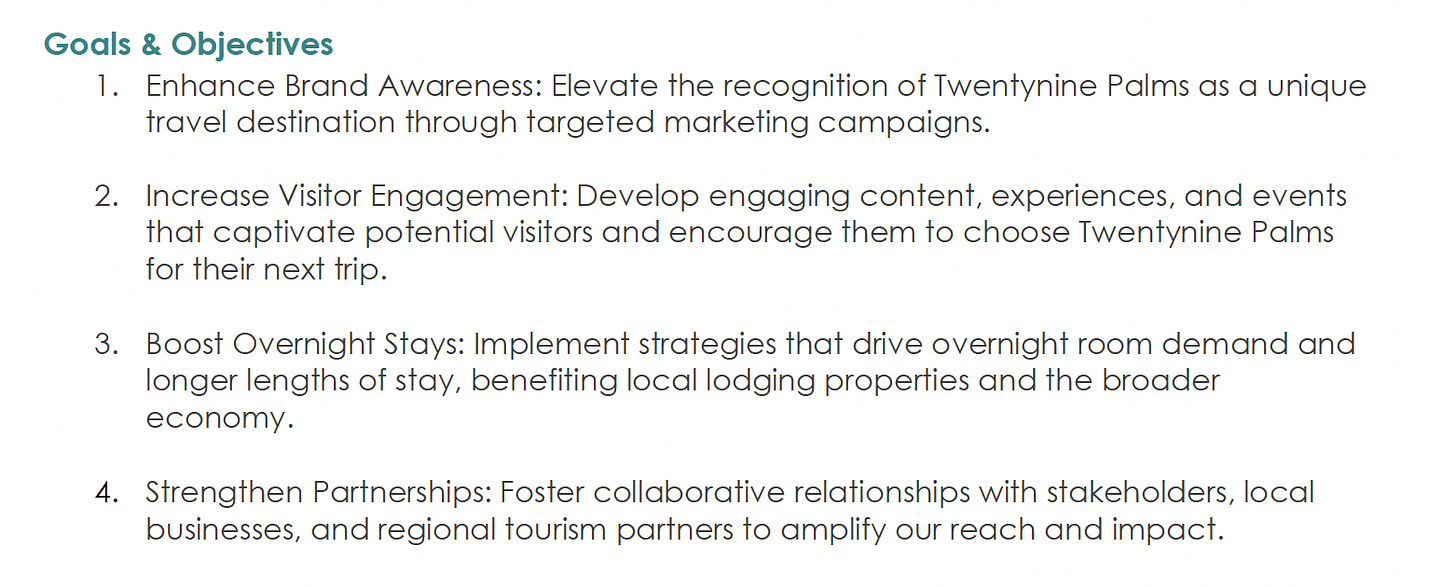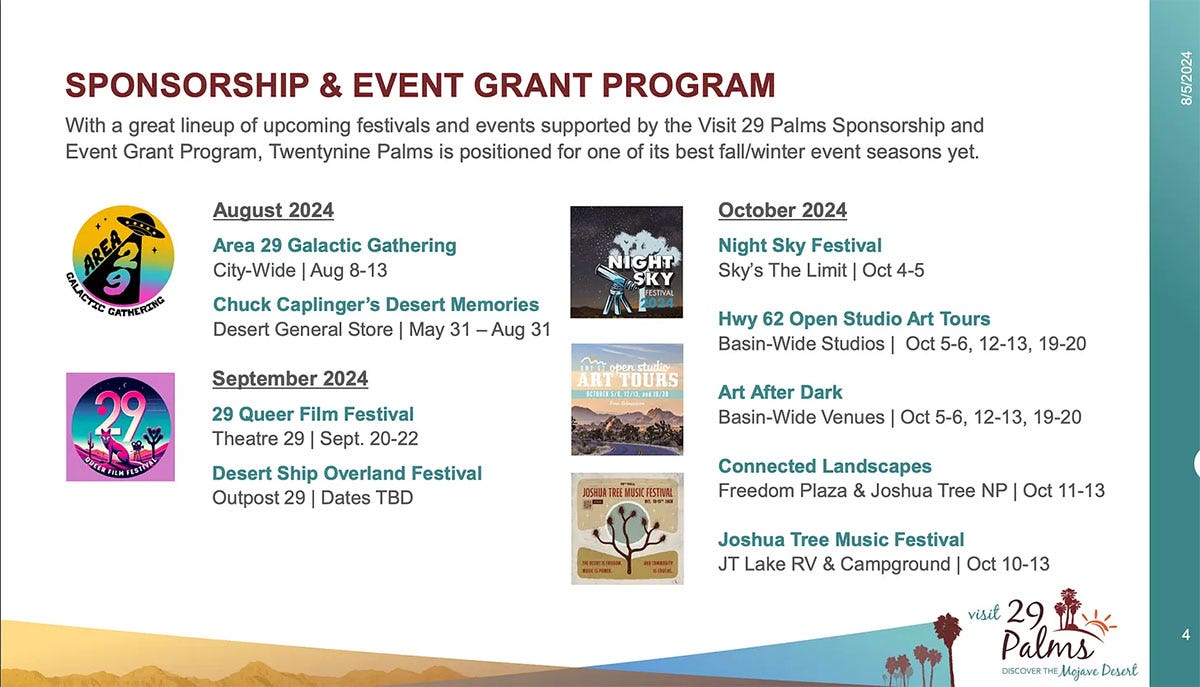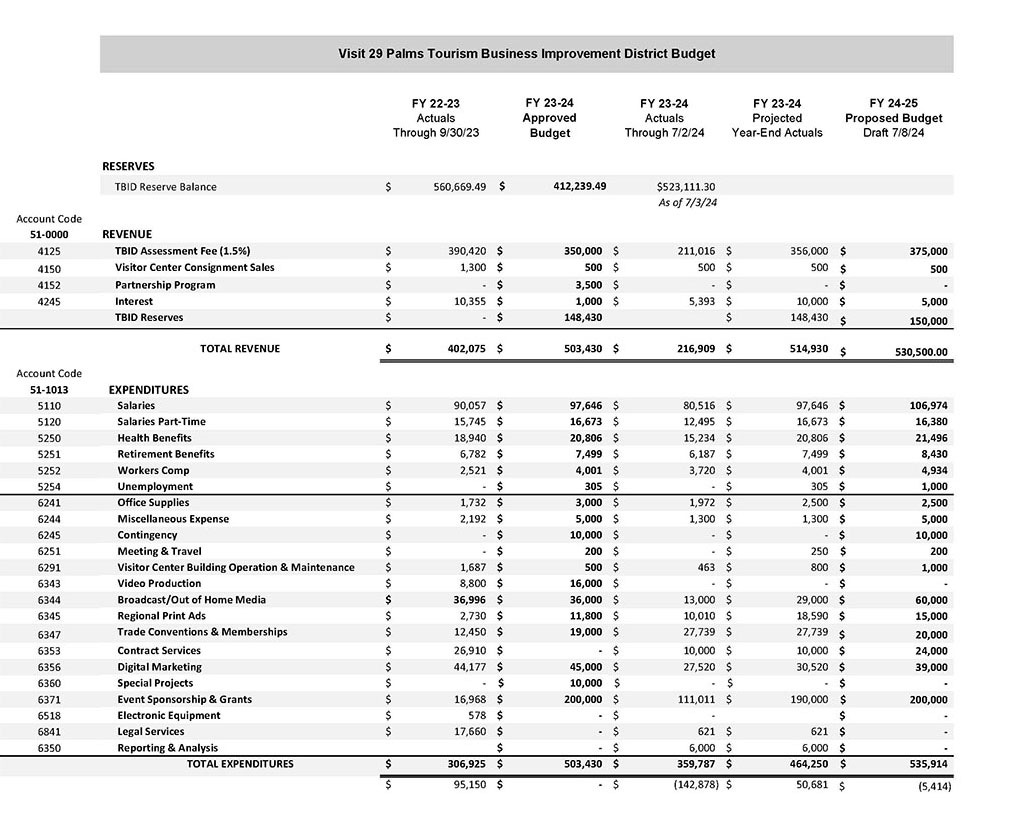Twentynine Palms TBID Presents Draft 2024-2025 Tourism Marketing Plan & Budget, August 8, 2024
It's much improved, but we have a few questions. Plus new Board Member Ben Uyeda of the RESET Hotel is sworn in
One thing that’s guaranteed, Twentynine Palms Tourism Business Improvement District (TBID) meetings are information packed, and the Thursday, August 8, meeting was no exception. The bulk of the meeting consisted of the presentation of the 16-page 2024-2025 Tourism Marketing Plan & Budget. We’ll do a brief review of the other items of business prior to diving into TBID’s draft marketing plans and budget for their next fiscal year. The full agenda is here.
Chair Rakesh Mehta, originally scheduled to participate by phone, ended up bowing out, leaving Vice-Chair Heidi Grunt and Board members Maria Madrid and Ashton Ramsey on the dais. They were soon joined by Reset Hotel owner Ben Uyeda, who was sworn in at the top of the meeting.
A regional marketing collaboration
The meeting kicked off with local business owner Eric Menendez pitching a regional marking collaboration between “Hi-Desert Municipal Stakeholders” such as the California Welcome Center in Yucca Valley and the Joshua Tree National Park Association and an extended list of “Hi/Low Desert Regional Partners.” The idea was generated in part by a video, shown by Menendez during his presentation, that featured a similar collaboration in West Virginia. Menendez plans to return with further details at a future meeting.
Marketing updates
Each meeting Marketing Director Breanne Dusastre reviews industry opportunities and earned media placements.1 This month’s report included a short piece in Travel and Leisure, a one night stop-over in Twentynine Palms by several travel agents on a familiarization tour, and an October Visit California media session in Los Angeles where Dusastre will pitch to several “top-tier travel and lifestyle media professionals.”
The Draft 2024-2025 Tourism Marketing Plan & Budget
The draft Tourism Marketing Plan and TBID budget was written by Marketing Director Dusastre working in collaboration with Chair Mehta and Board Member Ramsey. This yearly report is prepared as a part of the City Council reauthorization of the TBID, which operates on a October 1 - September 30 fiscal year. The TBID is an entity funded by a 1.5% pass-through tax paid by guests at overnight accommodations.
Last year the reauthorization landed at City Council following a contentious July 27 TBID meeting, which garnered the surprising Desert Trail headline of TBID BUDGET TALKS UNLEASH WRATH. At issue was the accumulation of more than $500,000 in reserves while denying funding requests for events from several local groups, among other concerns. The TBID didn’t fare much better at Council—it was initially canceled then reauthorized. Our reporting can be read via the article index by selecting “Tourism Business Improvement District (TBID).”
This year the TBID marketing plan and budget will be reviewed at City Council on September 10, and reauthorization is the subject of a public hearing at Council on September 24, leaving little time for the chaos of last year.
The budget and plan were presented in detail by Dusastre and consisted of overviews of the lodging market and the City, an analysis of the City’s strengths and weaknesses as a tourist destination, a marketing strategy, and an administrative description. Six pages of detail have been added to the marketing strategy over last year’s report. To better understand the evolution of the TBID in the last year, we compared sections of this year’s draft with last year’s plan with an eye toward addressing some of the issues raised last year with regard to use of data to support marketing decisions, critical analysis of board and administrative functions, and support for the general community.
Although some of those issues are addressed in the report — community is mentioned for the first time — not all plan initiatives are funded in the budget. Our remaining questions include: where is the real data collection, is there a good return on the investment (ROI) of assessment dollars, how are signature events supported long term, why does the social media remain so ineffective…and can TBID really do it all? Let’s dive in.
SWOT lacks depth and data
The plan includes a strengths, weaknesses, opportunities, and threats (SWOT) analysis, a tool commonly used by companies and other entities to evaluate their competitive position and lay a foundation for strategic planning. The SWOT included in the Marketing Plan and Budget appears to be targeted at the “Tourism District,” that is, Twentynine Palms’ strengths and weaknesses as a tourist destination.
Notably missing is a SWOT on the TBID organization itself, indicating that the critical self-examination called for at their last reauthorization is still lacking. What are the strengths and weaknesses of the TBID Board? What role does the TBID Board play in creating policy and setting budget priorities? What are the strengths and weaknesses in current staffing? Does the Board give effective direction to staff? What steps are taken to avoid burn out by Board members and staff?
A SWOT is driven by data, yet no data are cited to support the statements made under the SWOT categories. For instance, the top weakness reads, “Absence of a clearly defined identity.” How was this conclusion made? Were surveys distributed to visitors asking for their perception of the City, for instance? Another cited weakness, that growth in tourist amenities lags behind neighboring communities, fails to indicate which communities are being compared or provide any stats on retail or restaurant openings here in 29 or, say, in Joshua Tree. Several other statements are mostly simplified repeats of claims in last year’s SWOT, again without supporting data.
Greater attention paid to defining brand narratives and target markets
While the SWOT lacks data and depth, the Marketing Strategy shows greater attention to brand narratives and target audiences with newly outlined goals and objectives:
Following the Goals and Objectives is a new section highlighting brand narratives that appear to be elaborations of the five destination pillars regularly cited at TBID meetings and in the event grant guidelines:
1. Outdoor Recreation
2. Health and Wellness
3. Arts, Culture, History
4. Stargazing and Astronomy
5. Culinary
The new brand narratives “Art and Cultural Renaissance Hub,” “Gateway to Joshua Tree National Park,” “Exploration, Adventure, and Infinity,” “Oasis of the High Desert,” and “Historical Significance” include descriptions of brand positioning, elements and supporting events and activities.
Additionally, four target audiences are listed with each group further defined via demographics, psychographics and behavioral characteristics. Those groups are:
•Target Audience #1: Hipsters / Thrill Seekers / Flashpackers / Outdoor Enthusiasts / Off-the-Grid Travelers
•Target Audience #2: National Park Lovers / RVers / Eco-Adventurers / International Visitors (no age)
•Target Audience #3: Creative Retreat Seekers / Artists / Writers / Photographers / Health and Wellness Seekers
•Target Audience #4: Seasonal Sun Chasers / Snowbirds / Multigen Memory Makers
There is then further analysis for each audience as to how Twentynine Palms might be branded / positioned for that group and which media strategies should be used. Blog posts on the Visit29 website are the first option listed for three of the four audience groups and, as with other aspects of the report, it’s unclear what data were used to determine the match of marketing strategies to the defined groups—several strategies overlap between groups and reflect current TBID initiatives, such as the website, airport marketing and targeted Google ads.
Community is acknowledged
Although the role of event development could be given more weight in the report given the amount of funding allocated to it, the acknowledgment of community missing in prior reports is significant:
Events play a pivotal role in Twentynine Palms' tourism strategy, catering to a diverse array of visitors across all four target audience groups. Visit 29 Palms will remain committed to supporting its newly established Sponsorship and Event Grant Program in FY24-25, a program designed to foster the development of new and innovative events, increase industry collaboration and community engagement, and attract overnight visitors.
By seeding new events from national park-themed festivals and creative retreats to wellness expos and family-friendly activities, Twentynine Palms creates opportunities for engagement and exploration that resonate with each group's unique interests and preferences and increase visitors’ length of stay. Events not only showcase the city's natural beauty, cultural richness, and recreational offerings but also foster a sense of community and belonging among attendees.
This attention to community was echoed by Board Member Ramsey during the meeting:
And another thing just randomly, I would like to add is we we obviously don't want our town to change too much. But the reality is that from Los Angeles to Palm Springs, it's almost been filled in, and it's not always pretty. And there's a lot of places that are, just random cities that just fill in fast food, junk and all this stuff. So, we do have an opportunity, as people are coming here that are interested in small businesses and unique businesses and things, to make this a special community that is backed by tourism and backed by small businesses. So that's really the heart, I think, of the future of the town and the tourism and everything else, and that's what makes the town special.
New media and PR are added to the marketing programs
This section of the report is a less wordy cut and paste from the prior report and has brief summaries of the different initiatives such as Print Advertising, Airport and Out of Home Media (aka billboards). New in this report is a type of marketing that has been seriously lacking, media and public relations:
A dedicated media and public relations strategy will be implemented to generate positive press coverage and build strong relationships with journalists and media outlets. Through press releases, media kits, and targeted outreach, Visit 29 Palms will highlight key events, attractions, and unique stories, aiming to secure feature articles and broadcast segments that enhance the city's profile as a premier travel destination.
However, media and public relations is one of several items in the plan that aren’t delineated in the budget, which has little detail. A review of the marketing plans section provides some insight — for instance, “Digital Marketing” is allocated $39,000, and per Dusastre’s presentation, this is meant to cover four of the items listed as “Digital Marketing” under this topic: Website, Search Engine and Display Marketing and Email Marketing. Per Dusastre, the fifth item, Social Media, is the figure under contract services: $24,000.
Promised improved attention and analysis of metrics and key performance indicators (KPIs)
Being adjacent to a natural tourism draw like Joshua Tree National Park presents a challenge when assessing the effectiveness of TBID marketing. While Dusastre consistently points to assessment revenue as being the key metric, how does TBID untangle the assessment revenue from visitors who based their visit on the Park and happened to land in Twentynine Palms from those who choose to stay in Twentynine Palms because of TBID marketing? And taking that a step further, how does TBID analyze which forms of marketing are most effective?

Again, the 2024-2025 report expands on the six sentences given this topic last year and builds the prior focal points into specific goals:
•Increase TBID Assessment Revenue
•Enhance Lead Generation and Lodging Partner Referrals
•Expand Engagement, Reach, and Following Across Owned Channels
Each goal is supported by a strategy and a form of measurement. It’s likely that only visitor surveys will solve the larger question of Park vs. TBID, but this additional attention to the collection of data is promising…if funded. The 2024-2025 budget line item for reporting and analysis is zero.
Does the budget reflect the described marketing and new plan additions? Hard to say.
Organizational budgets are usually ordered with similar expenses grouped and subtotaled and personnel expenses grouped and subtotaled. So different expenses under the category “Marketing” would have a subtotal making it possible to compare that total cost with the cost of personnel, for instance. The TBID budget doesn’t follow that norm — instead, it’s organized by account codes. The only subtotals are “revenue” and “expenditures.”
The organization of the TBID budget also makes it difficult to ascertain how much funding is being allocated to each marketing initiative or whether some initiatives are funded at all. Several of the initiatives require content that involves writing, graphic design, photography and audio or video production and editing, yet the budget lacks line items for these services. New Board Member Ben Uyeda inquired about the $39,000 figure for Digital Marketing: “Is there any breakdown for content creation versus adspend?” Dusastre replied “Good question. There is not.“
Is Board direction for return on investment reflected in the budget?
Board member Ramsey brought up refocusing on “drive markets”—tourism emanating from locations within a drivable distance—as a budget consideration:
One of the major things that we were seeing or identifying or thinking on that was all the money that we might dump it into an airport, or dump it into something, and maybe getting someone from Wisconsin, they can come out once every six years. That may not get the same return as money that goes into the drive markets, where we can get all the new people that are very excited, starting businesses and coming back and forth and coming back and forth, you know, once a month, and bringing new people to the area.
Yet, $60,000 is allocated to airports (and MAYBE a few billboards) and another $20,000 to trade conventions and memberships that appear to mostly address national and international travel — Discover Inland Empire talked about Asian markets in their April presentation. That’s approximately 50% of the funds allocated to marketing.
How long before events become self sustaining?
The budget includes a $150,000 drawdown of the reserves to support events. Even with just a few months of funded events, it’s clear that some are potential signature events that will require on-going support to reach their potential. However, that level of drawdown is viable for about three years. Is it realistic that the signature events being developed from these funds such as Area 29 and the Book Festival will be self-sustaining in that time?
Per Dusastre:
Importantly to note, you know, while initial financial support is provided to launch these new events. When we think of this longer term, really, we're looking for these investments to help these events grow to become self sustainable, and really to see that they are financially independent and viable in the future.
How is this viability to be achieved when there is an ongoing question regarding the TBID’s role in marketing the events they fund? Marketing is required on the part of grantees who develop their own press releases and marketing materials and release them to the channels they have access to. But can these mostly small business be expected to have the contacts to amplify their efforts beyond the Morongo Basin? Isn’t it the TBID that presumably has those contacts and that reach?

For instance, TBID promotion of Area 29, a three-day festival tied to the Perseid meteor shower, which drives staggering numbers of people to Joshua Tree National Park, appeared to consist of five-second long reposts to their Visit 29 Instagram stories. While Area 29 began its IG account on May 30 with compelling “it’s coming” UFO themed graphics, those graphics are MIA in the Visit 29 Instagram posts. Unfortunately, the treatment of Area 29 is emblematic of the inconsistent social media utilization by the TBID. This is borne out by their 4,780 followers—this for an account that was established on September 29, 2016. By comparison, the Area 29 account, at 2-1/2 months old, has 2,477 followers
Is the Marketing Director really the TBID Director?
As was raised in public comment in a letter from Susan Peplow and by Eric Menendez, is there sufficient staff to do all that the TBID aspires to do per the 2024-2025 plan? While Board member Ramsey expressed the need for the TBID to function “in the leanest, meanest way” and for the limited funds to be as productive as possible, Menendez pointed out that the one full-time staff member, Dusastre, “can’t even go to lunch some days.”
Although Dusastre’s title is Marketing Director, given the responsibilities she’s tasked with, isn’t she more correctly described as the TBID Director? What other marketing director prepares board meeting agendas and accompanying PowerPoint presentations and organizational budget reports, manages a grant program and runs a visitor center, among other administrative tasks? Is it possible that the promotion of Area 29 was affected by the need to prepare the 16-page 2024-2025 Tourism Marketing Plan & Budget?
Which raises another question—while there are several positive additions to the marketing plan this year—who is going to have the time to consistently and successfully implement them?
Leave your thoughts in the comments below. Please note that we do not allow anonymous comments. Please be sure your first and last name is on your profile prior to commenting. Anonymous comments will be deleted.
Feel free to share this article!
Many communities in the Morongo Basin are economically disadvantaged, so our coverage will always be free. However, if you have the means to support our work, we always appreciate upgrades to a paid subscription. Your upgrade helps keep subscriptions free for those who cannot afford to donate.
Note that donations in excess of $100 are tax deductible to the extent allowed by law, and your subscription/donation will be listed as AHA Projects, the name of our fiscal receiver, on your statement. Donations over $100 can be made via the Aha Paypal.
An earned media placement is a newspaper or magazine story that is not a paid placement.








Yuck